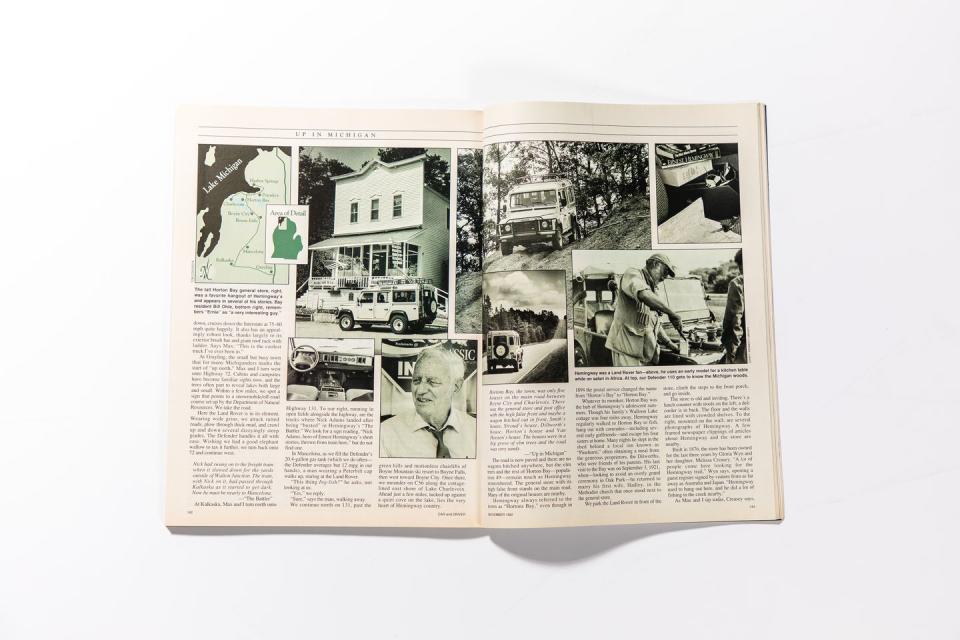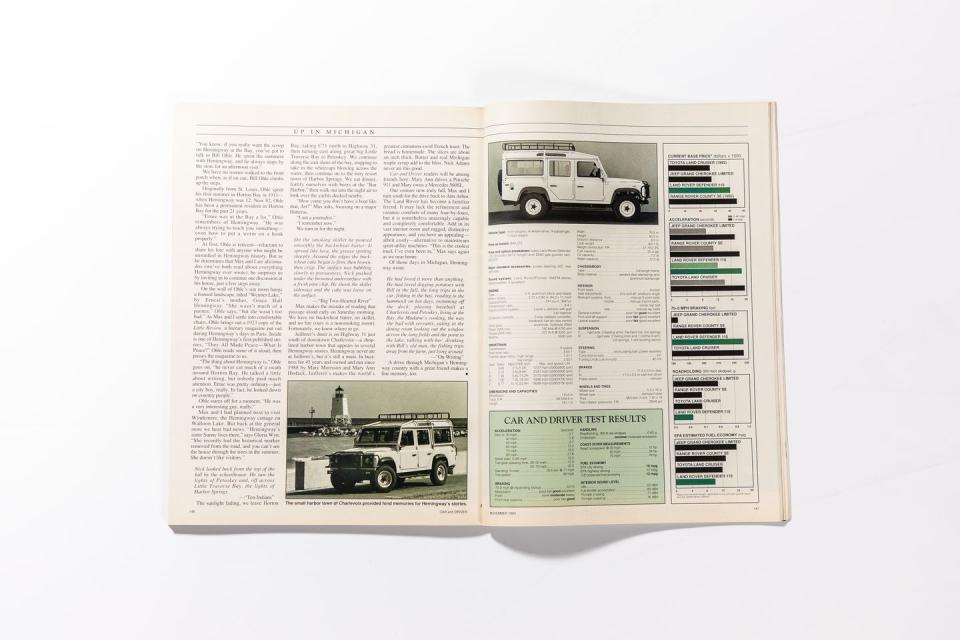Tested: 1993 Land Rover Defender 110 Heads North

I’ve written a number of stories about the Michigan country—the country is always true—what happens in the stories is fiction. —Ernest Hemingway, in a letter to his father, Paris, 1925.
Interstate 75 is unusually empty as the Land Rover rolls north from Ann Arbor. Ahead lie the woods, streams, lakes, and small towns of northern Michigan. My pal Max and I are off to see the Michigan countryside beloved by Ernest Hemingway, perhaps the best-known American novelist of our time and winner of the 1954 Nobel Prize in literature.
Though born and reared in Oak Park, Illinois, Hemingway spent the first eighteen summers of his life—1899 to 1917- in northern Michigan (he also returned for two more summers after being wounded in Italy while serving as a Red Cross ambulance driver during World War I. At his parents' cottage, "Windemere," on Walloon Lake south of Petoskey, he fished and swam and hunted. Years later, living in Paris, he drew on the memories of these experiences to craft many of his early short works-including the well-known Nick Adams stories.
The Land Rover is the official motive for our trip. After an eighteen-year absence from the U.S. market, this venerable machine—the "Daktari" sport-utility vehicle first introduced in 1948—is once again available on our shores. Dubbed the Defender 110, this latest edition is powered by a 180-horsepower 3.9-liter V-8 (the same engine offered in the current Range Rover), sports full-time four-wheel drive, comes only with a five-speed manual transmission, and sells for $40,575. Land Rover North America (until recently Range Rover of North America) is offering 500 of them for sale in the States.

As Max and I advance north, the flat farmland of central Michigan gives way to thick, rolling forests of birch and evergreen trees. By now, we have had ample opportunity to evaluate the Land Rover on-road. Named "110" for its 110-inch wheelbase, the Defender is a hulking machine. It stretches fifteen feet in length, stands seven and a half feet tall, and weighs 4911 pounds-despite its aluminum engine and body panels. And it feels truckish. The five-speed shifter has long throws, the clutch is heavy, and the engine revs with a burly roar.
Yet there are surprises. The ride is exceptionally compliant-almost plush. And the big Rover, which can seat nine people if the rear jump seats are folded down, cruises down the Interstate at 75-80 mph quite happily. It also has an appealingly robust look, thanks largely to its exterior brush bar and giant roof rack with ladder. Says Max: "This is the coolest truck I've ever been in."
At Grayling, the small but busy town that for many Michiganders marks the start of "up north," Max and I turn west onto Highway 72. Cabins and campsites have become familiar sights now, and the trees often part to reveal lakes both large and small. Within a few miles, we spot a sign that points to a snowmobile/off-road course set up by the Department of Natural Resources. We take the road.
Here the Land Rover is in its element. Wearing wide grins, we attack rutted roads, plow through thick mud, and crawl up and down several dizzyingly steep grades. The Defender handles it all with ease. Wishing we had a good elephant wallow to tax it further, we tum back onto 72 and continue west.
Nick had swung on to the freight train when it slowed down for the yards outside of Walton Junction. The train, with Nick on it, had passed through Kalkaska as it started to get dark. Now he must be nearly to Mancelona.—"The Battler"
At Kalkaska, Max and I tum north onto Highway 131. To our right, running in open fields alongside the highway, are the tracks where Nick Adams landed after being "busted" in Hemingway's "The Battler." We look for a sign reading, "Nick Adams, hero of Ernest Hemingway's short stories, thrown from train here," but do not find one.
In Mancelona, as we fill the Defender's 20.4-gallon gas tank (which we do often—the Defender averages but 12 mpg in our hands), a man wearing a Peterbilt cap walks up, staring at the Land Rover. "This thing Ing-lish?" he asks, not looking at us.
"Yes," we reply.
"Sure," says the man, walking away.
We continue north on 131, past the green hills and motionless chairlifts of Boyne Mountain ski resort to Boyne Falls, then west toward Boyne City. Once there, we meander on C56 along the cottage-lined east shore of Lake Charlevoix. Ahead just a few miles, tucked up against a quiet cove on the lake, lies the very heart of Hemingway country.

Hortons Bay, the town, was only five houses on the main road between Boyne City and Charlevoix. There was the general store and post office with the high false front and maybe a wagon hitched out in front, Smith's house, Stroud's house, Dillworth's house, Horton's house and Van Hoosen's house. The houses were in a big grove of elm trees and the road was very sandy.—"Up in Michigan"
The road is now paved and there are no wagons hitched anywhere, but the elm trees and the rest of Horton Bay-population 49-remain much as Hemingway remembered. The general store with its high false front stands on the main road. Many of the original houses are nearby. Hemingway always referred to the town as "Hortons Bay," even though in 1894 the postal service changed the name from "Horton's Bay" to "Horton Bay."
Whatever its moniker, Horton Bay was the hub of Hemingway's adolescent summers. Though his family's Walloon Lake cottage was four miles away, Hemingway regularly walked to Horton Bay to fish, hang out with comrades—including several early girlfriends—and escape his four sisters at home. Many nights he slept in the shed behind a local inn known as "Pinehurst," often obtaining a meal from the generous proprietors, the Dilworths, who were friends of his parents. His last visit to the Bay was on September 3, 1921, when—looking to avoid an overly grand ceremony in Oak Park—he returned to marry his first wife, Hadley, in the Methodist church that once stood next to the general store.
We park the Land Rover in front of the store, climb the steps to the front porch, and go inside.
The store is old and inviting. There's a lunch counter with stools on the left; a deli cooler is in back. The floor and the walls are lined with crowded shelves. To the right, mounted on the wall, are several photographs of Hemingway. A few framed newspaper clippings of articles about Hemingway and the store are nearby.
Built in 1876, the store has been owned for the last three years by Gloria Wyn and her daughter, Melissa Creasey. "A lot of people come here looking for the Hemingway trail," Wyn says, opening a guest register signed by visitors from as far away as Australia and Japan. "Hemingway used to hang out here, and he did a lot of fishing in the creek nearby."
As Max and I sip sodas, Creasey says, "You know, if you really want the scoop on Hemingway at the Bay, you've got to talk to Bill Ohle. He spent the summers with Hemingway, and he always stops by the store for an afternoon visit."

 Yahoo Autos
Yahoo Autos 